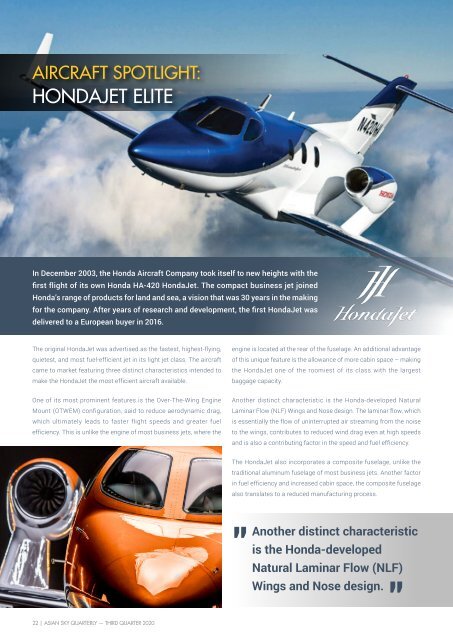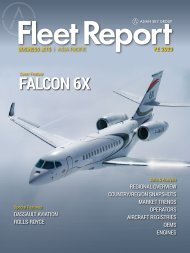You also want an ePaper? Increase the reach of your titles
YUMPU automatically turns print PDFs into web optimized ePapers that Google loves.
AIRCRAFT SPOTLIGHT:<br />
HONDAJET ELITE<br />
In December 2003, the Honda Aircraft Company took itself to new heights with the<br />
first flight of its own Honda HA-420 HondaJet. The compact business jet joined<br />
Honda’s range of products for land and sea, a vision that was 30 years in the making<br />
for the company. After years of research and development, the first HondaJet was<br />
delivered to a European buyer in 2016.<br />
The original HondaJet was advertised as the fastest, highest-flying,<br />
quietest, and most fuel-efficient jet in its light jet class. The aircraft<br />
came to market featuring three distinct characteristics intended to<br />
make the HondaJet the most efficient aircraft available.<br />
engine is located at the rear of the fuselage. An additional advantage<br />
of this unique feature is the allowance of more cabin space – making<br />
the HondaJet one of the roomiest of its class with the largest<br />
baggage capacity.<br />
One of its most prominent features is the Over-The-Wing Engine<br />
Mount (OTWEM) configuration, said to reduce aerodynamic drag,<br />
which ultimately leads to faster flight speeds and greater fuel<br />
efficiency. This is unlike the engine of most business jets, where the<br />
Another distinct characteristic is the Honda-developed Natural<br />
Laminar Flow (NLF) Wings and Nose design. The laminar flow, which<br />
is essentially the flow of uninterrupted air streaming from the noise<br />
to the wings, contributes to reduced wind drag even at high speeds<br />
and is also a contributing factor in the speed and fuel efficiency.<br />
The HondaJet also incorporates a composite fuselage, unlike the<br />
traditional aluminum fuselage of most business jets. Another factor<br />
in fuel efficiency and increased cabin space, the composite fuselage<br />
also translates to a reduced manufacturing process.<br />
Another distinct characteristic<br />
is the Honda-developed<br />
Natural Laminar Flow (NLF)<br />
Wings and Nose design.<br />
22 | ASIAN SKY QUARTERLY — THIRD QUARTER <strong>2020</strong>

















